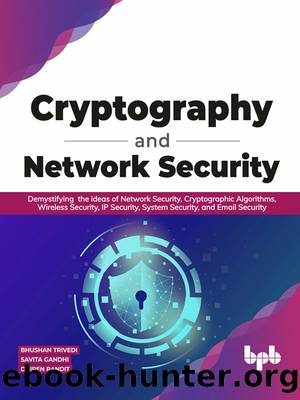Cryptography and Network Security by Bhushan Trivedi & Savita Gandhi & Dhiren Pandit

Author:Bhushan Trivedi & Savita Gandhi & Dhiren Pandit [Trivedi, Bhushan & Gandhi, Savita & Pandit, Dhiren]
Language: eng
Format: epub
ISBN: 9789389328660
Publisher: BPB Publications
Published: 2022-10-15T00:00:00+00:00
12.3 How it works
The idea of asymmetric key encryption is quite simple. We assume two keys, PrKey and a PuKey, for each user. The users communicate with each other by encrypting anything by the receiverâs public key. The receiver, on receipt, decrypts it by his own private key.
Sounds simple, isnât it? However, simple it looks like, it is not in the actual sense. The public and private keys are related to each other, without which the preceding conditions cannot be satisfied. The problem is how to stop an attacker with one key (the public key) to learn about the other key (the private key). We will soon see how that is possible to be achieved. We have already hinted about them in chapter 8. In short, the answer is that the algorithms are designed in such a way that generating the key pair is possible using a single operation but learning about the other key from one key demand multiple operations that are infeasible to be carried out in real-time.
The private key (PrKey) is kept with the user and disclosed to nobody. The other key (the PuKey) is purposefully disclosed to everybody who wants to have communication with the user.
If you diligently look at this solution, you can see that this system solves some of the problems that we have mentioned earlier in the section, The need for public-key systems. When anybodyâs public key is available (over some form of the directory) to anybody, including a stranger can send anything to that person by encrypting using the receiverâs public key. This guarantees that only the intended receiver, who is in possession of his own private key, can open it and nobody else. The receiver does not need to keep multiple keys, only his public key knowledge is enough for many senders to communicate to him.
Also, the encrypting key, the public key, is public knowledge and there is no harm if it is known even to the attacker. So, sharing a public key does not compromise security. The most important part is that there is no need to share the private key with anybody!
Download
This site does not store any files on its server. We only index and link to content provided by other sites. Please contact the content providers to delete copyright contents if any and email us, we'll remove relevant links or contents immediately.
| Cryptography | Encryption |
| Hacking | Network Security |
| Privacy & Online Safety | Security Certifications |
| Viruses |
Effective Threat Investigation for SOC Analysts by Yahia Mostafa;(7439)
Practical Memory Forensics by Svetlana Ostrovskaya & Oleg Skulkin(7159)
Machine Learning Security Principles by John Paul Mueller(7120)
Attacking and Exploiting Modern Web Applications by Simone Onofri & Donato Onofri(6790)
Operationalizing Threat Intelligence by Kyle Wilhoit & Joseph Opacki(6759)
Solidity Programming Essentials by Ritesh Modi(4549)
Microsoft 365 Security, Compliance, and Identity Administration by Peter Rising(4142)
Operationalizing Threat Intelligence by Joseph Opacki Kyle Wilhoit(3886)
Learn Computer Forensics - Second Edition by William Oettinger(3632)
Building a Next-Gen SOC with IBM QRadar: Accelerate your security operations and detect cyber threats effectively by Ashish M Kothekar(3623)
Future Crimes by Marc Goodman(3535)
Blockchain Basics by Daniel Drescher(3514)
Mastering Azure Security by Mustafa Toroman and Tom Janetscheck(3480)
Mastering Python for Networking and Security by José Manuel Ortega(3454)
Incident Response with Threat Intelligence by Roberto Martínez(3366)
The Code Book by Simon Singh(3080)
Mastering Bitcoin: Programming the Open Blockchain by Andreas M. Antonopoulos(2988)
Mobile App Reverse Engineering by Abhinav Mishra(2963)
From CIA to APT: An Introduction to Cyber Security by Edward G. Amoroso & Matthew E. Amoroso(2867)
